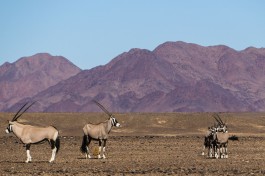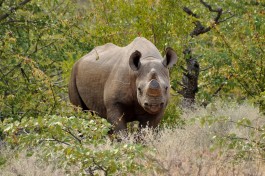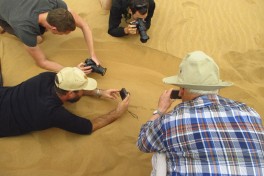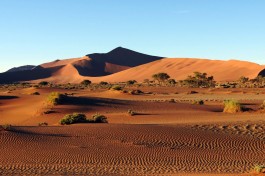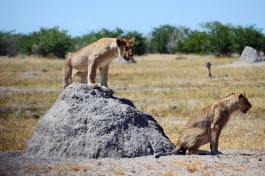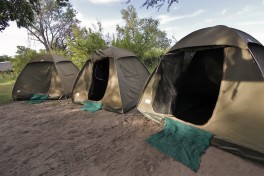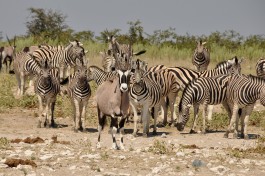Wild Namibia Camping Safari
Summary of this Budget Safari Package
This small group 4×4 safari is ideal for nature lovers and camping enthusiasts in search of real adventure in Namibia.
Explore secluded and hidden gems, from the lofty Gamsberg Pass to the unspoilt Rostock Mountains on the fringes of the Namib Desert. Venture off the beaten track at Namibia’s famous natural highlights, experiencing the wilder western part of Etosha National Park, the untamed Erongo region of Damaraland and a private concession area in the remote Kunene Region.
At night we camp in scenic wild places, taking in the incredible starry night skies of Namibia and soaking up the peace and solitude of unspoilt nature. By day we journey through breathtaking mountain passes, arresting Namib Desert landscapes and semi-desert plains, along dramatic coastline and into the rugged wilderness regions. See ancient San rock art and extraordinary geological wonders formed over millions of years; get a taste of traditional and contemporary Namibian culture and watch African wildlife and birds in their natural habitats.
Itinerary for this Tour
Day 1: Windhoek to Gamsberg – Namibia
This Namibia Camping Adventure departs from Windhoek, the capital of Namibia.
On the first morning you meet up with your guide in Windhoek and drive southwest to Gamsberg Mountain. This flat-topped mountain, shaped like a table, is part of the Hakos Mountains, a steep range of fold mountains.
Our first overnight campsite is on the Gamsberg Pass, the highest mountain pass in Namibia. Making our way up the long, winding pass we ascend to about 2347 metres (7770 feet) above sea level. First, we set up camp and take time out to absorb the peaceful mountain scenery.
In the afternoon we explore the Gamsberg area, taking in the sweeping views over the Kuiseb River Valley and Namib Desert in the distance. This untamed region is home to a variety of wild animals, some of which we may encounter on our exploration. Keep an eye out for mountain zebras, kudus and striking oryx antelopes.
Tonight we have dinner around the campfire and gaze up at the star-studded skies. Gamsberg is an excellent place for stargazing given the predominantly clear skies, remote location and high altitude.
- Meals included: Lunch & Dinner
- Travel: 150km / about 2 to 3 hours
Day 2: Gamsberg to Sesriem – Namibia
Day two begins with a hearty breakfast at our campsite in the Hakos Mountains. Then we pack up and continue our journey southwards, travelling through open farmlands and deserted wild landscapes.
Today’s scenic drive takes us over the imposing Spreetshoogte Pass, offering stunning views over the dramatic surrounding landscapes. Sopping at a viewpoint on the Spreetshoogte Pass we admire the vistas of the Namib Desert below. Then we follow the steep, winding road down to the open plains of the Khomas region, passing the small desert outpost of Solitaire en route to our next stop, Sesriem. Sesriem is a small settlement in the Namib Desert, near the Naukluft Mountains and Sesriem Canyon.
This afternoon we head to Sesriem Canyon and take a walk in the narrow gorge. In Sesriem we view layer-upon-layer of sedimentary rock, exposed through millions of years of erosion by the ephemeral Tsauchab River.
Tonight we camp in Sesriem, settling down around the campfire underneath wide desert skies.
- Meals included: Breakfast, Lunch & Dinner
- Travel: 250km / about 3 to 4 hours
Day 3: Sossusvlei to Rostock – Namibia
Wake up before sunrise, getting an early start for our adventures in the mesmerising Namib Desert.
We set off into Namib-Naukluft National Park before dawn, reaching the Sossusvlei region in time for a spectacular sunrise over the orange-red dunes. Watch the shifting shadows on the fine sands of some of the tallest dunes in the world, as you sip on your morning coffee. Photographic opportunities abound as the rising sun lights the landscape up in brilliant shades of warm colours.
After coffee and rusks we move on to the clay pans of Sossusvlei and Deadvlei, where pale, cracked clay stands in stark contrast with the surrounding ochre dunes and vivid blue skies. Walk around between the twisted dead tree trunks scattered across the bleached salt and clay pans, taking in the otherworldly desert scenes and capturing the surreal imagery on camera.
Then we return to camp and have a big brunch, before packing up. From Sesriem we drive to our next camp at the foot of the Rostock Mountains, on the outskirts of the Namib Desert. The afternoon is free for rest and relaxation at the quirky lodge, overlooking the barren gravel plains and mountains of this quiet area. Camping out here, in the middle of nowhere, we are surrounded by unspoilt nature with starry skies above.
- Meals included: Brunch & Dinner
- Travel: 250km / about 3 to 4 hours
Day 4: Rostock to Swakopmund – Namibia
An early morning walk before sunrise is the best way to start day four. Or kick-off the day with a swim in the pool looking out over the bush. Get out into nature in the solitary hours before dawn, absorbing the stillness and spaciousness of the arid plains and mountains at this magical time of day.
Back at camp, your guide serves up a well-deserved breakfast and we get ready to travel onwards.
The next stretch of road brings us to Swakopmund, on the rugged coast of Namibia. Here we top-up on modern comforts and conveniences, after our time out in the secluded Namib region. The icy Atlantic Ocean and bustle of this seaside town offer a pleasant change of pace and cool breeze. In the afternoon you embark on a city tour of Swakopmund, visiting the sights and highlights of the historic town. Swakopmund, like Windhoek, has strong German influences, visible in the old colonial buildings, historic sights and contemporary cuisine, language and culture.
In the evening you can eat out at one of the local restaurants, known for fresh seafood and German inspired dishes, and sample the nightlife. Tonight we stay at a guesthouse, taking a break from camping for one night.
- Meals included: Breakfast
- Travel: 250km / about 3 hours
Day 5: Swakopmund to Brandberg – Namibia
On day five we have breakfast at the guesthouse in Swakopmund and get back on the road again.
Driving north along the dramatic Skeleton Coast we head to Cape Cross. Here we stop to view one of the world’s largest breeding colonies of Cape Fur Seals. Over 100 000 seals gather on the headland at Cape Cross – an incredible sight, accompanied by overpowering smells and sounds. After our sensory experience with the seals we travel inland to Brandberg Mountain in Damaraland. Namibia’s tallest mountain, the name Brandberg means ‘burning mountain’, so-named for its fiery colours at sunset.
First we set up camp in the dry Ugab riverbed and then we head to the famous White Lady rock painting. A local guide takes us to view some of the numerous San rock paintings of Brandberg and explore the area on foot. After our guided walk we return to our camp under the acacia trees and take time out to rest and unwind. We may spot desert elephants and other animals that sometimes visit the area around camp.
Settle down around the flickering campfire for a peaceful night at our secluded camp in the Erongo region.
- Meals included: Breakfast, Lunch & Dinner
- Travel: 300km / about 4 to 5 hours
Day 6: Brandberg to Palmwag – Namibia
Today we drive further north into the remote Kunene Region of north-western Namibia.
Near the small town of Khorixas, we take a detour to the ancient Petrified Forest to view the remarkable collection of tree fossils, formed over 250 million years ago. The proclaimed national monument of the Petrified Forest, includes around 50 fossilised tree trunks that can be seen scattered across the dry riverbed. Some of the fossilised trees, which were washed here during a flood, are as long as 34 metres, with circumferences of up to 6 metres!
We also pause to inspect an old Welwitschia Miralibis specimen up close. These hardy succulents are thought to live to about 1500 years, if not older, miraculously surviving in the semi-desert conditions of the Namib. Next we visit the unique geological formation called the Organ Pipes – a series of ancient basalt columns near Twyfelfontein. Some of the rust-brown pillars rise up to five metres tall, forming an impressive wall of rock resembling the pipes of a church organ.
Arriving at our next camp in Palmwag, we freshen up, take a swim in the pool, and set off on a game drive. Driving through the private concession area we look out for antelopes, small predators and other fascinating creatures that inhabit this 5000km² wilderness reserve. The concession area is home to healthy wildlife populations, including sizeable predator populations. With some luck we may encounter lions, endangered black rhinos and desert-adapted elephants, along with jackals, hyenas and cheetahs. Giraffe, zebra and various antelope species, such as gemsbok, kudu and springbok, are often spotted.
During our drive we stop in a scenic spot to watch a beautiful sunset over the bush, sundowners in hand. Then we head back to our oasis-like camp along the Uniab River, scanning the wilderness for animals as the light fades. Tonight we are in for a treat, enjoying a lovely dinner out at a restaurant.
- Meals included: Breakfast, Lunch & Dinner
- Travel: 250km / about 3 to 4 hours of driving
Day 7: Palmwag to Etosha National Park – Namibia
This morning we set off for Namibia’s leading game park, Etosha National Park.
Our route takes us along the gravel road to Kamanjab, via the spectacular Grootberg Pass onto the Grootberg Plateau. Pausing at the top of the pass, we stretch our legs and admire the breathtaking views over the Klip River Valley and surrounding koppies and mountains.
From Kamanjab we drive to the Galton Gate of Etosha Park, located in the far south-western section of the park. Driving into the less-visited western region of the park we pass through boulder-strewn hills and open plains, watching for wildlife. The previously restricted western area of Etosha hosts high numbers of wildlife, including endangered black rhinos. Chances of spotting antelopes and other animals are high, as we drive to Olifantsrus Camp in the wild northwestern part of Etosha Park. Sightings in this remote region include the unusual black-faced impala, Hartmann’s mountain zebra and roan and sable antelopes.
Arriving at Olifantsrus we set up camp and relax. Head to the split-level hide to watch wildlife and birds at the watering hole. Elephants are regularly seen from the raised wooden decks of the glass-fronted hide, along with black rhino, Burchell’s zebra, springbok, gemsbok and blue wildebeest. The waterhole also attracts an array of birds, including ostriches, bateleurs, kori bustards, snake eagles, secretary birds, black-shouldered kites and korhaans.
- Meals included: Breakfast, Lunch & Dinner
- Travel: 200km / about 2 to 3 hours
Day 8: Etosha National Park – Namibia
We get up bright and early, starting the day with tea, coffee and rusks at camp. By the time the sun rises we are out in the bush, watching for wildlife already. Early mornings are ideal for game viewing, because many of the birds and animals are more active at this time and the temperatures are still mild.
Our 4×4 game drive takes us to various watering holes in search of the animals and birds that congregate at these precious water sources. We may see elephants, rhinos, lions, cheetahs, giraffes, black-faced impalas and other game. The game drive is followed by a big breakfast back at camp. Then we pack up and continue east through Etosha Park, game viewing en route to our next camp at Okaukuejo.
Spend time at the flood-lit watering hole this evening, for excellent chances of sighting lions, rhinos, elephants and other nocturnal visitors.
- Meals included: Breakfast, Lunch & Dinner
Day 9: Etosha National Park – Namibia
Enjoy a second day of game viewing in world-famous Etosha!
Embark on a morning and afternoon game drive, providing ample opportunities to appreciate the rugged beauty of Etosha’s landscapes and see its wild creatures. On today’s game drives we visit more watering holes, stopping to photograph and watch the wild animals interact, bathe, drink and feed.
Etosha is considered one of the top game parks in Africa, known for its dramatic wildlife sightings in the harsh, open terrain surrounding Etosha Pan. Keep an eye out for elusive leopards in the shaded tree branches – one of the rare African wildlife sightings.
On the last night of our Namibia Camping Safari you have the option of embarking on an exciting night game drive with the official rangers of Etosha National Park. Venturing out into the African bush after dark is a memorable experience offering a new perspective and unexpected wildlife encounters. Alternatively you can return to the floodlit watering hole at Okaukuejo to see what wildlife luck brings tonight.
- Meals included: Breakfast, Lunch & Dinner
Day 10: Etosha National Park to Windhoek – Namibia
Our final day begins with a delicious breakfast at our camp in Etosha. Leaving the wildlife-rich bush behind we drive south to Windhoek, the last stop on our Wild Namibia Camping Safari.
Along the way we visit the famous market at Okahandja to browse the locally made goods, from wood carvings to woven baskets and handmade jewellery.
Reaching Windhoek this afternoon your guide transfers you to the airport or your post-tour hotel, where it is time to say farewell.
- Meals included: Breakfast & Lunch
- Travel: 450km / 5 to 6 hours
Please note:
This small group safari travels with six guests at most, guaranteeing each client a window seat.
Spacious two-person tents are used on the tour and comfortable sleeping mats are provided, as well as all the necessary camping equipment.
Image Gallery
Click the image to enlarge
![]()



